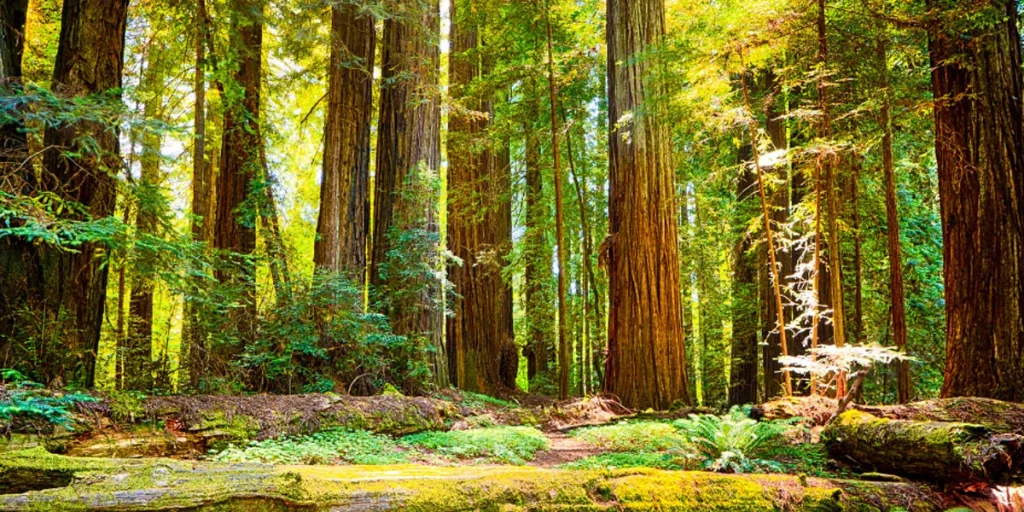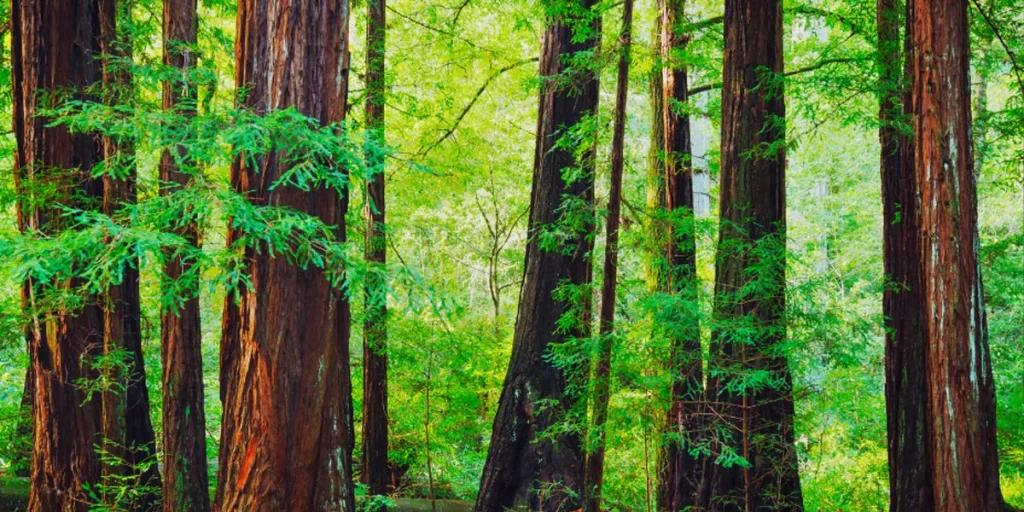A mature Redwood tree can weigh over 500,000 pounds. The weight varies depending on the tree’s age and size.
Considering the majesty of redwoods, these trees are renowned for their immense stature and exceptional lifespan.
Redwood trees, found primarily in California’s coastal regions, spark immense curiosity and wonder due to their colossal dimensions.
They stand as natural towers, often reaching heights well above 300 feet, which can be equated to a 30-story building.
Their impressive mass is not just about height but also about the substantial wood volume they encompass.
As tourists crane their necks skyward, researchers and forest management professionals meticulously calculate the weight and biomass of these giants for ecological and conservation purposes.
Understanding the staggering weight of redwoods is crucial for appreciating their role in carbon sequestration and the broader ecosystem, illuminating why these ancient sentinels of the forest captivate scientists and nature enthusiasts alike.
The Majesty Of Redwood Trees
The very essence of nature’s grandeur can be captured by casting one’s gaze upon the mighty Redwood trees.
These living monoliths, soaring skyward, are not only among the tallest and most awe-inspiring trees on the planet, but they are also steeped in ecological importance.
The weight of a Redwood tree is not just measured in pounds and tons, but also in its monumental presence and the sheer awe it inspires in onlookers.
Characteristics Of These Forest Giants
Redwood trees, known scientifically as Sequoioideae, are recognized for their immense size.
With a bark that can grow up to 12 inches thick and trunks wide enough for a car to drive through, these trees are true giants of the forest.
Their height can reach well over 350 feet, making them taller than a 30-story building! That’s just the tip of the iceberg when it comes to their fascinating traits.
- Age: Redwoods are known to live for thousands of years, with some dated at over 2000 years old.
- Weight: Mature Redwoods can weigh a staggering 500,000 pounds or more, equivalent to about 40 African elephants!
- Tolerance: They are incredibly resistant to fire, diseases, and rot due to their thick bark and tannin-rich wood.
Where Redwoods Reign: Geographic Distribution
Redwood trees find their home along the coast of northern California and a stretch into southern Oregon.
This region, often cloaked in a layer of fog from the Pacific Ocean, provides the perfect setting for Redwoods to thrive. The following locations are sanctuaries for these majestic trees:
- Redwood National and State Parks
- Humboldt Redwoods State Park
- Muir Woods National Monument
- Jedediah Smith Redwoods State Park
Each park provides a unique ecosystem where the Redwood trees play a vital role. These ecosystems support a vast array of wildlife and help maintain the ecological balance.
Size And Scale: Redwoods In Numbers

The majestic Redwood trees are awe-inspiring natural wonders. Their vast size is almost beyond belief.
Let’s dive into the impressive numbers that these giants boast. We will explore just how tall and wide they can grow, revealing why they are considered the skyscrapers of the forest.
Height And Diameter: A Tape Measure To The Sky
Redwood trees reach astonishing heights. They stand tall like nature’s towers. Here’s a glimpse of their incredible dimensions:
- Average height: Between 200 to 240 feet
- Record height: A staggering 379.7 feet
- Typical diameter: Up to 22 feet at their base
Equating them to human-made structures, redwoods can be as tall as a 35-story building. These numbers help us imagine the enormity of these trees, but standing beneath one is the only way to truly experience their grandeur.
Age Rings To The Past: Estimating The Age
Redwoods can live for millennia. Their rings tell stories of the past:
| Measurement | Details |
|---|---|
| Average lifespan: | 500 to 700 years |
| Oldest known: | Over 2,200 years old |
Weighing The Giants: The Heft Of Redwoods

Imagine standing at the foot of a redwood tree, its top disappearing into the mist above.
These ancient spires of the natural world are not just towering but also astonishingly hefty.
Calculating The Mass Of A Redwood
Estimating the weight of a redwood is a complex process.
It requires a blend of science and math to bring us close to an accurate figure.
- Measure the tree’s height and diameter.
- Determine its volume through mathematical models.
- Account for the wood’s density to get mass.
For instance, a 100-foot redwood with a diameter of 10 feet may weigh around 250 tons.
Factors Affecting The Weight
Multiple variables dictate how heavy a redwood can be.
Each factor plays a crucial role in the final weigh-in.
| Factor | Impact on Weight |
|---|---|
| Height | Taller trees have more mass. |
| Girth | Wider trees are heavier. |
| Age | Older trees accumulate bulk. |
| Water Content | Wet wood weighs more than dry. |
| Density | Dense wood increases overall mass. |
By considering these elements, experts can approximate a redwood’s weight.
From Seed To Skyscraper: The Growth Of Redwoods
Imagine a tiny seed growing taller than a 30-story building. This is the journey of a redwood, nature’s towering marvels.
From Seed to Skyscraper: The Growth of Redwoods tells an inspiring story. Redwoods rise from modest beginnings to become massive pillars of the forest.
Life Cycle Of A Redwood Tree
Every giant redwood starts from a seed no bigger than a tomato seed. Despite their small size, they grow into the largest trees on Earth.
- Germination: Redwood seeds require sunlight and moist soil to begin their life.
- Sapling Stage: Those which survive pests and weather become saplings, enjoying rapid growth.
- Mature Redwoods: After 50 to 100 years, they count among the forest’s elders.
- Reproduction: Mature trees release seeds each year, continuing the cycle.
Achieving The Immense Size: Growth Factors
Redwoods are not just tall; they are enormous in width and weight, too. Key factors contribute to their immense size:
- Ideal Climate: Redwoods thrive in the foggy, cool climate of the Pacific Coast.
- Rich Soil: Nutrient-dense soil provides the necessary resources for growth.
- Efficient Photosynthesis: Their leaves capture sunlight all year, enabling constant growth.
Conservation Efforts
Redwood trees awe us with their size, but they face real problems. Conservation efforts are crucial to keep these giants standing tall.
Threats To The Redwood Population
Redwoods face many threats, both natural and human-made.
- Climate change impacts their habitats.
- Illegal logging reduces their numbers.
- Development cuts into their living space.
Protecting The Titans: Conservation And Restoration
Efforts to save redwoods are growing. Here’s what’s happening:
- Parks preserve large redwood areas.
- Organizations plant new redwoods.
- Scientists study how to protect them.
Laws and regulations make sure these actions succeed.
FAQs About the Weight of a Redwood Tree
How Much Does An Average Redwood Tree Weigh?
Redwood trees, known for their impressive size, can weigh approximately 1. 6 million pounds for mature specimens.
This weight accounts for the tree’s immense height and thick trunk diameter.
What Factors Affect The Weight Of A Redwood Tree?
The weight of a redwood tree depends on its age, height, and diameter.
Older and taller redwoods with greater trunk diameters will generally weigh more due to the increased amount of wood.
Can Redwood Trees Weigh Over A Million Pounds?
Yes, mature Redwood trees can exceed a million pounds. Some of the tallest and oldest specimens reach this weight due to their substantial size and wood volume.
How Is The Weight Of A Redwood Tree Estimated?
The weight of a Redwood tree is estimated using calculations based on its height, diameter, and wood density.
These factors help foresters approximate the overall mass without cutting down the tree.
Conclusion
Understanding the weight of a redwood tree offers a peek into nature’s grandeur. These arboreal giants can tip the scales at over a whopping 1,000,000 pounds! Their mass reflects age, growth conditions, and redwood species.
Keep in mind the importance of conserving these majestic trees as natural wonders that continue to inspire awe and provide invaluable ecological benefits.
Remember, each tree’s weight tells a story of resilience and time.
Resources:
https://earthobservatory.nasa.gov/biome/seedredwood.php
https://capitolmuseum.ca.gov/state-symbols/tree-california-redwood/
